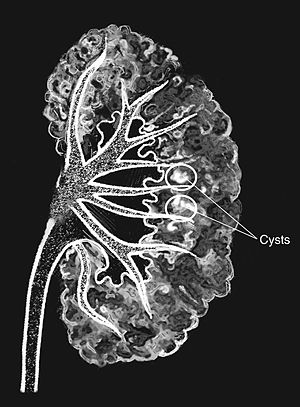Medullary sponge kidney
| Medullary sponge kidney | |
|---|---|
 |
|
| Medullary sponge as seen on an intravenous pyelogram | |
| Classification and external resources | |
| Specialty | medical genetics, nephrology |
| ICD-10 | Q61.5 |
| ICD-9-CM | 753.17 |
| DiseasesDB | 7915 |
| eMedicine | article/379323 |
| MeSH | D007691 |
Medullary Sponge Kidney (also known as Cacchi–Ricci disease) is a congenital disorder of the kidneys characterized by cystic dilatation of the collecting tubules in one or both kidneys. Individuals with medullary sponge kidney are at increased risk for kidney stones and urinary tract infection (UTI). Patients with MSK typically pass twice as many stones per year as do other stone formers without MSK. While described as a "benign" disorder with a low morbidity rate, as many as 10% of patients with MSK have an increased risk of morbidity associated with frequent stones and UTIs. While some patients report increased chronic kidney pain, the source of the pain, when a UTI or blockage is not present, is unclear at this time. Renal colic (flank and back pain) is present in 55% of patients. Women with MSK experience more stones, UTIs, and complications than men. MSK was previously believed not to be hereditary but there is more evidence coming forth that may indicate otherwise.
Most cases are asymptomatic or are discovered during an investigation of blood in the urine. Symptomatic patients typically present as middle-aged adults with renal colic, kidney stones, nephrocalcinosis and/or recurrent urinary tract infections; however, MSK also may affect children very rarely. In addition to the typical clinical phenotype of recurrent stone disease, other clinical profiles have now been recognized, that is, an indolent, almost asymptomatic MSK, and a rare form characterized by intractable pain.
In recent studies, insight has been obtained on the genetic basis of this disease, supporting the hypothesis that MSK is due to a disruption at the 'ureteric bud-metanephric mesenchyme' interface. This explains why so many tubular defects coexist in this disease, and particularly a distal tubular acidification defect of which the highly prevalent metabolic bone disease is one very important consequence. In addition to the typical clinical phenotype of recurrent stone disease, other clinical profiles have now been recognized, that is, an indolent, almost asymptomatic MSK, and a rare form characterized by intractable, excruciating pain. It was previously believed that most cases of Medullary Sponge Kidney were sporadic however, recent studies show familial clustering of MSK is common and has an autosomal dominant inheritance, a reduced penetrance, and variable expressivity. Other theories suggest that dilatation of a collecting duct may occur, caused by occlusion by uric acid during fetal life or resulting from tubular obstruction due to calcium oxalate calculi secondary to infantile hypercalciuria.
...
Wikipedia
